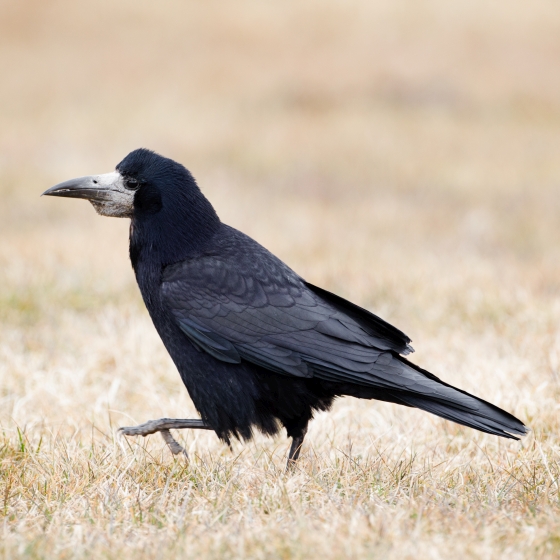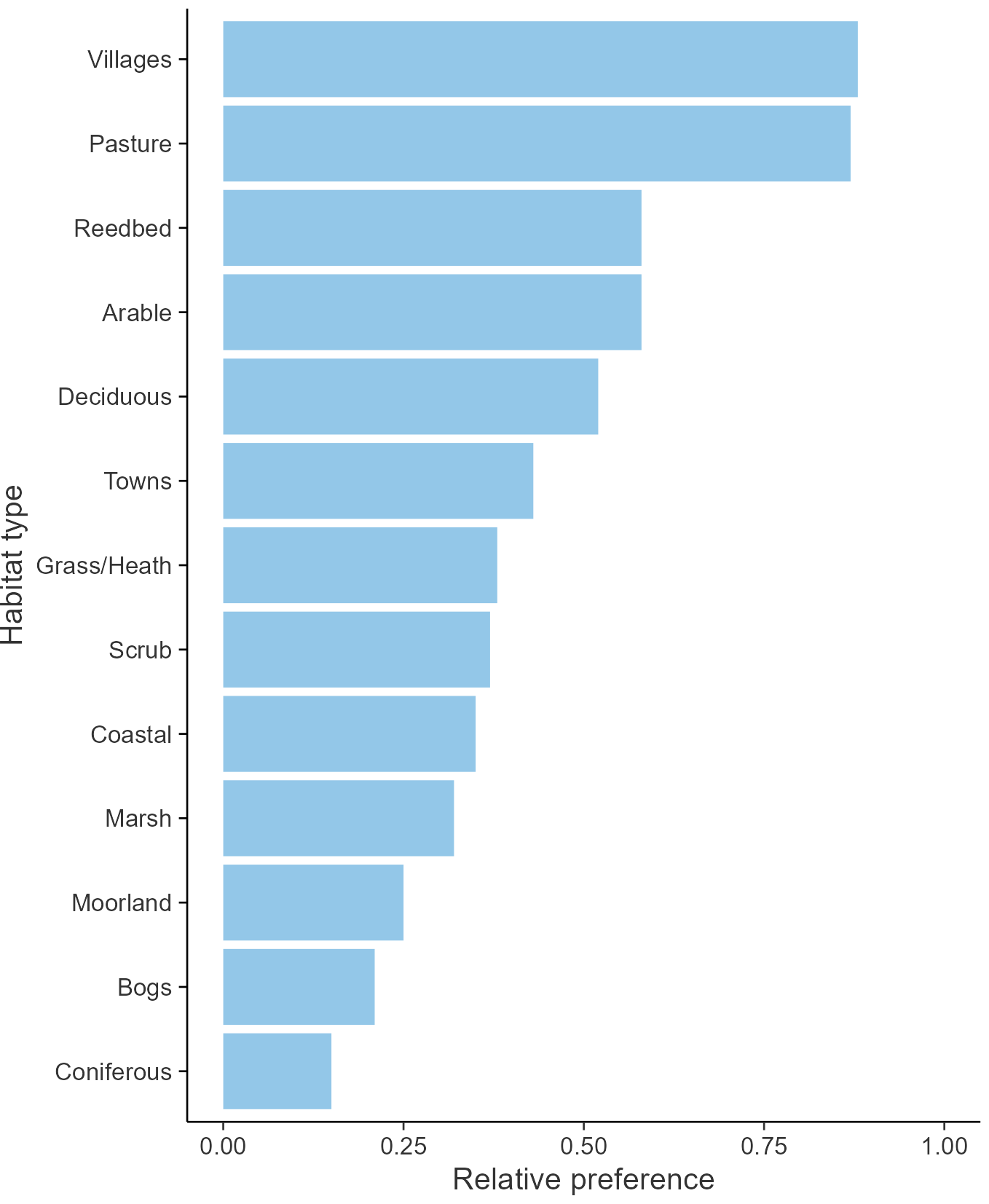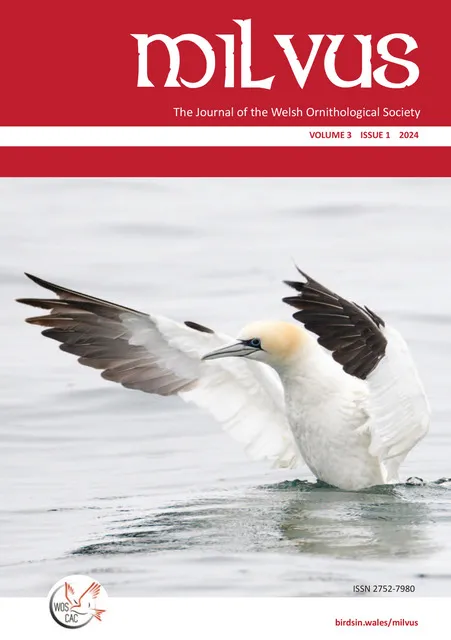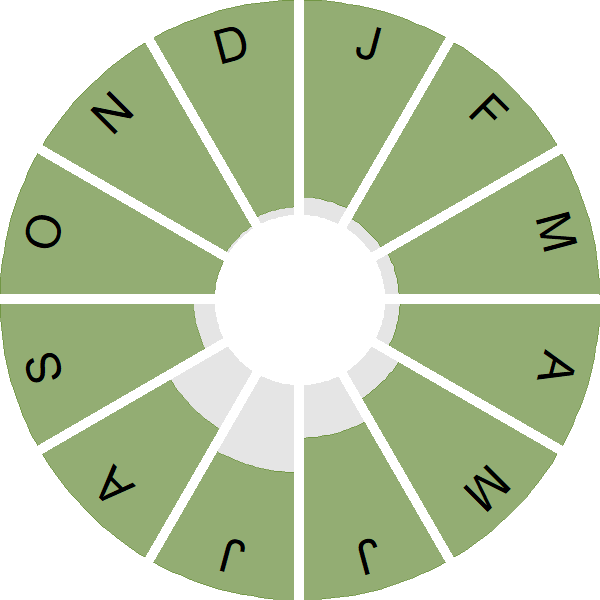Rook

Introduction
Of the five species of black 'crows' found in the UK, the Rook can be told by its cone-shaped head and bare-skinned face.
The Rook is a very sociable bird. It feeds in large, garrulous flocks in its favoured farmland habitat, seeking out a variety of seeds, roots and soil invertebrates. Rooks are colonial nesters, building their nests within a metre or two of their neighbours. Once established, these rookeries can be enduring; some are known to have been in use at the same site for over 100 years.
The Rook is a widespread and common bird, found all across the UK. It is a resident species that has experienced population declines since about the year 2000, particularly in Wales and Scotland.
- Our Trends Explorer gives you the latest insight into how this species' population is changing.

Key Stats
Identification
ID Videos
This section features BTO training videos headlining this species, or featuring it as a potential confusion species.
Corvids
Songs and Calls
Call:
Status and Trends
Conservation Status
Population Change
Relatively few rookeries fell within CBC plots, but an index calculated from the available CBC nest counts showed a shallow, long-term increase (Wilson et al. 1998). Increase to the mid 1990s was confirmed by the results of the most recent BTO rookeries survey, which identified a 40% increase in abundance between 1975 and 1996 (Marchant & Gregory 1999). This increase probably reflected the species' considerable adaptability in the face of agricultural change. BBS indices, which are drawn from sightings during transect walks and not from BBS's nest counts, suggest that a notable decrease has occurred subsequently, affecting all countries within the UK, particularly Wales and Scotland. The BBS map of change in relative density between 1994-96 and 2007-09 indicates that there had been increases during that period in Northern Ireland and in lowland regions of England and Wales but decreases in many upland areas and in eastern coastal areas of Scotland. There has been little change in breeding productivity since the 1960s but a decrease in brood size is now becoming evident. There has been an increase across Europe since 1980 (PECBMS: PECBMS 2020a>).
Distribution
Rooks maintain a nearly ubiquitous distribution across much of Britain & Ireland. Though they are absent from larger conurbations, such as London, the lowland distribution of Rooks includes virtually every 10-km square with major gaps confined to higher ground in Scotland, parts of northern England, Wales and the rugged far northwest of Ireland. Rooks favour open, lowland countryside, being less abundant through the wooded Wealden counties of England, for example, than in the arable east of Britain or the eastern and southern counties of Ireland. In general, Rooks are more abundant in Ireland than in Britain.
Occupied 10-km squares in UK
2007/08–10/11
or view it on Bird Atlas Mapstore.
2008–11
or view it on Bird Atlas Mapstore.
European Distribution Map
Distribution Change
There have been only relatively small changes in the distribution of Rooks over the last 40 years. Since the 1968–72 Breeding Atlas some losses have occurred in and around the fringes of the species' northerly range, in the Scottish Highlands, and also in northwest Ireland.
Change in occupied 10-km squares in the UK
from 1981–84 to 2007–11
or view it on Bird Atlas Mapstore.
from 1968–72 to 2008–11
or view it on Bird Atlas Mapstore.
Seasonality
Rook is recorded throughout the year on up to 30% of complete lists.
Weekly pattern of occurrence
The graph shows when the species is present in the UK, with taller bars indicating a higher likelihood of encountering the species in appropriate regions and habitats.

Habitats
Breeding season habitats
Relative frequency by habitat
The graph shows the habitats occupied in the breeding season, with the most utilised habitats shown at the top. Bars of similar size indicate the species is equally likely to be recorded in those habitats.

Movement
Britain & Ireland movement
Foreign locations of birds ringed or recovered in Britain & Ireland
Dots show the foreign destinations of birds ringed in Britain & Ireland, and the origins of birds ringed overseas that were subsequently recaptured, resighted or found dead in Britain & Ireland. Dot colours indicate the time of year that the species was present at the location.
- Winter (Nov-Feb)
- Spring (Mar-Apr)
- Summer (May-Jul)
- Autumn (Aug-Oct)

European movements
EuroBirdPortal uses birdwatcher's records, such as those logged in BirdTrack to map the flows of birds as they arrive and depart Europe. See maps for this species here.
The Eurasian-African Migration Atlas shows movements of individual birds ringed or recovered in Europe. See maps for this species here.
Biology
Productivity and Nesting
Nesting timing
Egg measurements
Clutch Size
Incubation
Fledging
Survival and Longevity
Survival is shown as the proportion of birds surviving from one year to the next and is derived from bird ringing data. It can also be used to estimate how long birds typically live.
View number ringed each year in the Online Ringing Report.
Lifespan
Survival of adults
Survival of juveniles
Biometrics
Wing length and body weights are from live birds (source).
Wing length
Body weight
Ring Size
Classification, names and codes
Classification and Codes
- Order: Passeriformes
- Family: Corvidae
- Scientific name: Corvus frugilegus
- Authority: Linnaeus, 1758
- BTO 2-letter code: RO
- BTO 5-letter code: ROOK.
- Euring code number: 15630
Alternate species names
- Catalan: graula
- Czech: havran polní
- Danish: Råge
- Dutch: Roek
- Estonian: künnivares
- Finnish: mustavaris
- French: Corbeau freux
- Gaelic: Ròcais
- German: Saatkrähe
- Hungarian: vetési varjú
- Icelandic: Bláhrafn
- Irish: Rúcach
- Italian: Corvo comune
- Latvian: kraukis
- Lithuanian: paprastasis kovas
- Norwegian: Kornkråke
- Polish: gawron (zwyczajny)
- Portuguese: gralha-calva
- Slovak: havran cierny
- Slovenian: poljska vrana
- Spanish: Graja
- Swedish: råka
- Welsh: Ydfran
Research
Causes of Change and Solutions
Causes of change
There is little good evidence available regarding the drivers of the breeding population increase in this species in the UK.
Further information on causes of change
No further information is available.
Information about conservation actions
Although it is believed that numbers increased during the late twentieth century, the drivers of the subsequent decline in the current century are unknown and further research is needed before evidence-based conservation actions can be proposed to reverse the recent declines.
In the meantime and until further research confirms the drivers of the population changes, actions to restore or create species-rich grassland and to provide other foraging habitats may benefit rooks. As a colonial nesting species, it could also be vulnerable to exploitation of rookeries by humans and predators, and therefore actions and policies to protect breeding sites may also be prudent.
Publications (2)
Status and distribution of Rook Corvus frugilegus in Wales in 2022/23
Author: Hereward, H.F.R., Brenchley, A., Facey, R.J., Hughes, J., Lindley, P.J., Taylor, R.C., Wilson, M.W. & Macgregor, C.J.
Published: 2024
In 2022 and 2023, the Welsh Ornithological Society (WOS) coordinated a countrywide colony survey of Rooks in Wales, to estimate population and distribution size and change.
25.12.24
Papers

Birds of Conservation Concern Wales 4: the population status of birds in Wales
Author: Johnstone, I.G., Hughes, J., Balmer, D.E., Brenchley, A., Facey, R.J., Lindley, P.J., Noble, D.G. & Taylor, R.C.
Published: 2022
The latest review of the conservation status of birds in Wales. The report assessed all 220 bird species which regularly occur in Wales. There are now 60 species of bird on the Red List, with 91 on the Amber List and just 69 - less than a third of the total number of species - on the Green List. The latest review of the conservation status of birds in Wales comes 20 years after the first, when the Red List was less than half the length it is today. The report assessed all 220 bird species which regularly occur in Wales. There are now 60 species of bird on the Red List in Wales, with 91 on the Amber List and 69 on the Green List. The Birds of Conservation Concern in Wales report assesses the status of each species against a set of objective criteria. Data sources include the BTO/JNCC/RSPB Breeding Bird Survey and the BTO/RSPB/JNCC Wetland Bird Survey, as well as Bird Atlases and other BTO-led monitoring schemes and citizen science initiatives. These are used to quantify the changing status of the species’ Welsh population. The UK, European and global conservation status of the species is also considered, placing the Welsh population into a wider context. The Red ListSwift, Greenfinch and Rook – familiar breeding species in steep decline across the UK – are among the new additions to the Welsh Red List, which now also includes Purple Sandpiper, on account of a rapidly shrinking Welsh wintering population, and Leach’s Petrel, an enigmatic seabird in decline across its global range. These species now sit alongside well-known conservation priorities, such as Curlew, Hen Harrier and Turtle Dove as birds at risk of being lost from Wales for good. Uplands and woodlands Many of the species on the Red List are found in upland and farmland habitats. Starling, Tree Sparrow, Yellow Wagtail and Yellowhammer can no longer be found in much of Wales, while iconic species of mountain and moorland, such as Ring Ouzel, Merlin and Black Grouse, remain in serious trouble. Wales is well known for its populations of woodland birds; however, many of these – including Lesser Spotted Woodpecker, Willow Warbler and Spotted Flycatcher – also feature on the Red List. Goldcrest, which has seen its Welsh population shrink alarmingly in recent decades, is another new addition. On the coast The assessment for Birds of Conservation Concern Wales 4 took place before the impacts of avian influenza could be taken into account. Breeding seabird species have been struggling in Wales for many years, however, and most were already of conservation concern before the outbreak of this disease. Kittiwake, Puffin, Black-headed Gull, and Common, Arctic and Sandwich Tern remain on the Red List. Wales holds internationally significant numbers of breeding seabirds, making the decline of these colonies a global concern. The Amber ListDeclines in Wheatear, Garden Warbler and House Martin - all migrants which breed in Europe and winter in sub-Saharan Africa - mean these species have moved from the Green List to the Amber List. Many other ‘Afro-Palearctic' migrant species are also in decline, but the potential reasons for this, such as habitat loss and reduced availability of invertebrate prey, are not well understood. Closer to home, the declines in the Welsh Chaffinch population, linked to the disease trichomonosis, have seen the species Amber-listed. A number of other species have been placed on the Amber List because of the wider importance of their Welsh populations, which in each case make up more than half the UK total. Wales is home to more than three-quarters of the UK’s Choughs, for example, so recent declines are cause for concern. The nation’s breeding populations of Manx Shearwater, Pied Flycatcher, Goshawk and Hawfinch also account for more than half the UK total, as does its wintering population of Spotted Redshank. It’s not all bad news, though: some species now on the Amber List have moved up from the Red List, indicating some positive change in their population trends. These include Common Sandpiper, Great Black-backed Gull, Bullfinch, Goldcrest and Pied Flycatcher. The Green ListWhile the report contains much cause for alarm, several conservation success stories shine through. Red Kite was almost lost as a British bird during the first half of the 20th century, when only a handful of pairs remained in remote Welsh valleys. Since then, a sustained conservation effort has brought the species back from the brink. Wales is now home to more than 2,500 pairs of Red Kite and the species has now been moved to the Green List, reflecting this incredible change in fortunes. Song Thrush, Reed Bunting, Long-tailed Tit, Redwing and Kingfisher are among the other species to have gone Green, providing much-needed hope that things can go up as well as down.
06.12.22
Reports Birds of Conservation Concern

More Evidence
More evidence from Conservation Evidence.com
Partners
Citing BirdFacts
If you wish to cite particular content in this page (e.g. a specific value) it is best to use the original sources as linked in the page. For a more general citation of the whole page please use: BTO (20XX) BirdFacts Species: profiles of birds occurring in the United Kingdom. BTO, Thetford (www.bto.org/birdfacts, accessed on xx/xx/xxxx).

